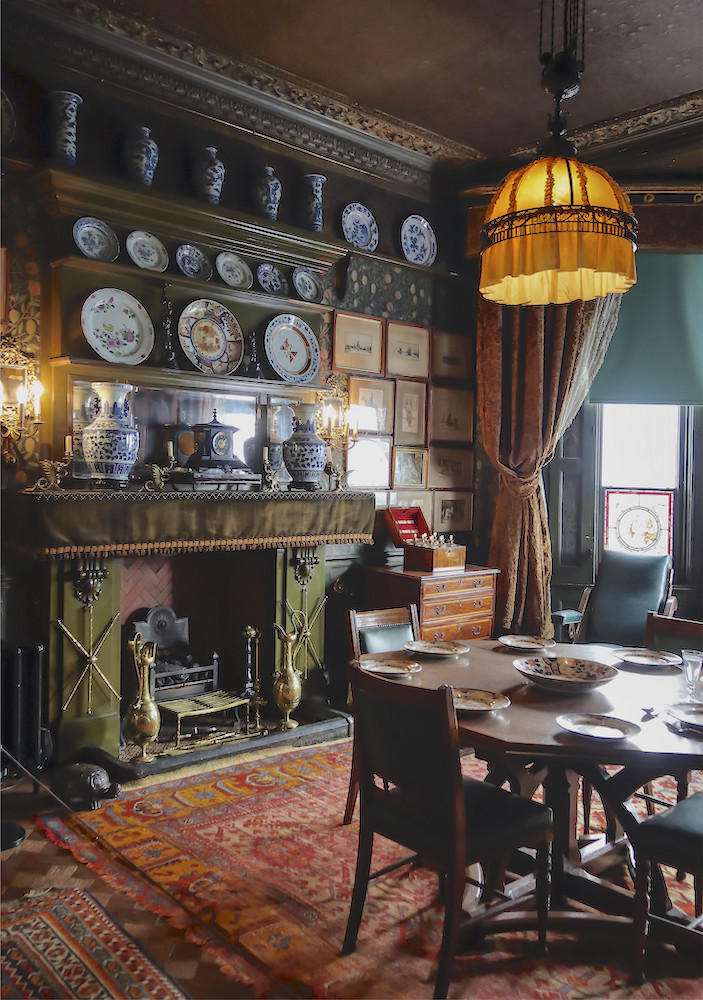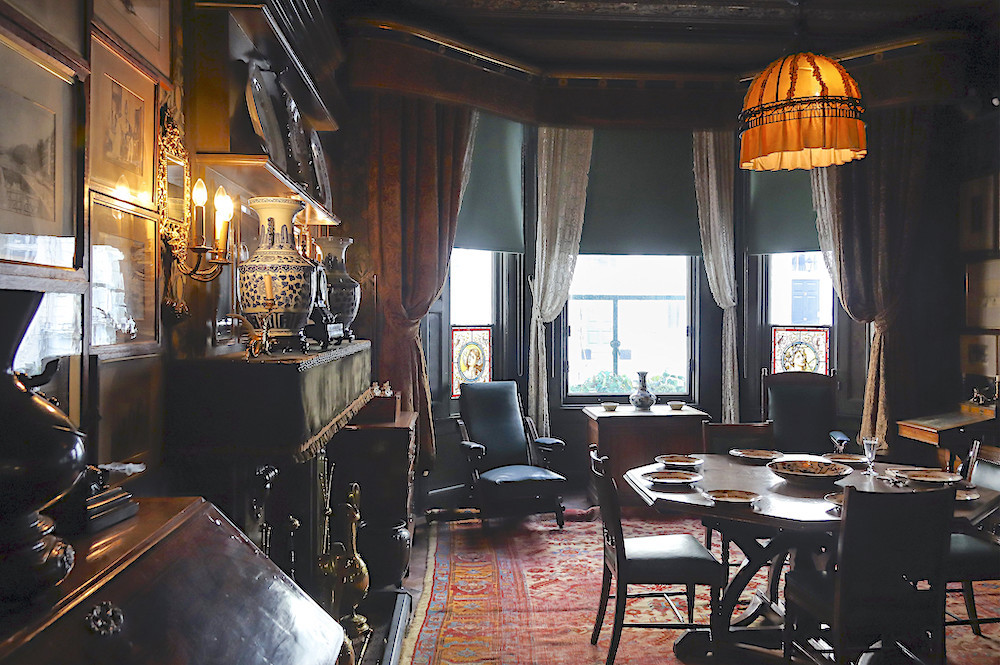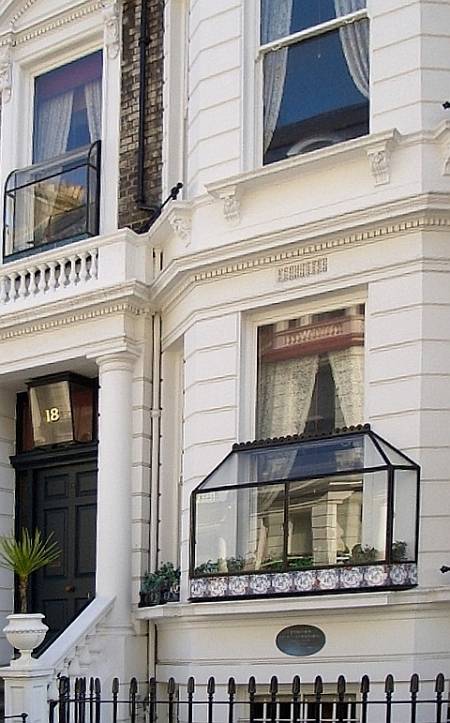
18 Stafford Terrace (click on this for more
information).
Just one block north of bustling Kensington High Street lies Stafford Terrace, a street of substantial Victorian family houses, built for the prosperous middle classes. Dating from the 1860s, the stuccoed, classically-inspired exteriors conceal an array of interiors reflecting the changing fashions in taste and lifestyle since the time of their original owners.
But number 18 has remained virtually unchanged since its 1880s heyday, when it was home to the successful Punch cartoonist, illustrator and photographer Edward Linley Sambourne, his wife Marion, their children Maud and Roy and an assortment of live-in servants and animals.
Retaining the Sambournes’ elaborate decoration, furnishings, art works and enthusiastically collected treasures, the house is a unique and important resource for the study of Victorian architecture and design, as well as social and artistic life.
Over the years, the curators of this historic house museum have introduced various methods of interpretation to bring the house and its inhabitants to life and to maximise understanding and enjoyment for visitors. This has encompassed an introductory video, illustrated information panels, guided tours, volunteer room stewards, hand-held printed information and, for special events and school groups, costumed actors in the guise of Marion Sambourne or the Cook conducting visitors around "their" house.
But from September, a new and exciting layer has been added to the mix, a Soundscape installed in the Dining Room. As one of the most important spaces in the house, where the Sambourne’s loved to entertain a wide circle of friends and where Sambourne himself delighted in good food and drink (often to the detriment of his health!), a great deal of care and money was lavished on the room. With its Morris and Co. wallpapers and embossed "leather" paper, antique and contemporary furniture, blue and white oriental porcelain and stained glass panels, the Dining Room was the Sambournes’ pride and joy. And, of course, the successful running of it all depended on the hard work of the cook and housemaids.

A view of the Dining Room (photo credit, KotomiCreations, reproduced
under the terms of the Creative Commons licence, CC BY-NC 2.0).
The new audio installation has been created by Elizabeth Langfeld, Sound Artist and Musician. Her recent online project for the Victoria and Albert Museum, "A Tree Story - a Celebration of Trees in Photography," is a magical slide show of arboreal images chosen from the museum’s vast collection of historic photographs, accompanied by Langfeld’s evocative soundtrack. She has now used her impressive skills to fulfill the brief for Sambourne House of creating an immersive experience, stimulating the senses and suggesting the life of a Victorian home filled with sound and activity. This new offering is also intended to widen the appeal of the museum and encourage return visits.
For Langfeld, the project has been a stimulating creative challenge - to add a layer of sound to a real, physical space, with already strong, but silent, visual impact. Based on the quest for authenticity, her research included delving into the extensive Sambourne archive for detail about the lives and activities of the family and their servants. Sounds were recorded in the Dining Room, using original objects where possible, for example, the clink of cutlery as the table is laid, drinks being poured into glasses and the tick tock of the clock; doors open and close and footsteps cross the floor. Other sounds were sourced from audio libraries, including the crackle of the open fire and the wheeze of the bellows, the clip clop of horses hooves in the street, the song of birds and the mewing of the family cat, whom Marion Sambourne mentions in her diary as having promptly "decorated" the plants newly installed in the fern case in the window!

Another view of the Dining Room (photo credit, KotomiCreations, reproduced under the terms of the Creative Commons licence, CC BY-NC 2.0).
Particularly evocative is a sequence where the sounds of indoor activity are layered with a horse neighing in the distance, the chiming bells of St Mary Abbot’s, the Sambournes’ parish church and a heavy shower of rain, contrasting with the cosy space within the home.

The fern case in the Dining Room window
(click on this for more information).
The Soundscape has been customized for the space, utilizing cutting-edge digital recording and production technology to create stereophonic, layered sound with panning, giving the impression that noises are coming from different points within the room as well as at varying distances from the streets outside. The recording is on a five-minute loop, encouraging visitors to remain for a repeat and prolong the experience. The equipment is unobtrusive with two tiny, but powerful concealed speakers and it is simple to operate for museum staff, only requiring the flick of a single on-off switch.
The Soundscape is supported by a hand-held information sheet identifying the sounds to be heard, together with a suggested scenario for visitors who might like to imagine a lively Sambourne dinner party in full flow.
Among initial reactions from visitors on the first day the new installation was available to the public, were that the addition of sound made the room very atmospheric, that it enhanced their experience, conjured another world, reminded them of grandparents’ homes or encouraged them to stay longer in the space. Recognising sounds, such as the mewing of the cat, provoked laughter. Unaccompanied mothers felt that it would be a great stimulus for children to interact with and respond to. Others commented that the sound enabled them to better identify with the space or made it feel more real, that they could imagine people sitting around the table or working in the room.
Ongoing, more rigorous assessment will be carried out, but so far, indications are that the new Soundscape at Sambourne House provides scope for engaging memory and imagination for a broad range of visitors, helping to bring a sense of the past into the present and encouraging them to come again and bring their family and friends.
Links to Related Material
- Linley Sambourne (1844-1910): A Short Biography
- 18, Stafford Terrace (Sambourne House)
- Mr Sambourne at Home: An Interview with Mr. Punch’s Chief Cartoonist (1901)
- Review of Shirley Nicholson's A Victorian Household: Based on the Diaries of Marion Sambourne
- "Out Shopping: The dresses of Marion and Maud Sambourne (1880-1910)" (exhibition review)
- [Outbound link] Sambourne House, on the museum's own website
Created 13 September 2025